Input Tax Credit and GST Rulings
VerifiedAdded on 2020/04/07
|12
|1982
|33
AI Summary
The assignment delves into the complexities of input tax credit within the Goods and Services Tax (GST) framework. It examines GSTR 2006/3, a taxation ruling that clarifies methods for determining input tax credit eligibility under the new GST Act 1999. The analysis focuses on 'extent' and 'to the extent' doctrines applied in interpreting GST legislation, using the case of Ronpibon Tin NL v. FC of T as an example. It further explores how advertising expenses incurred by Big Bank Ltd for creditable acquisitions can be claimed as input tax credit based on GSTR 2006/13.
Contribute Materials
Your contribution can guide someone’s learning journey. Share your
documents today.
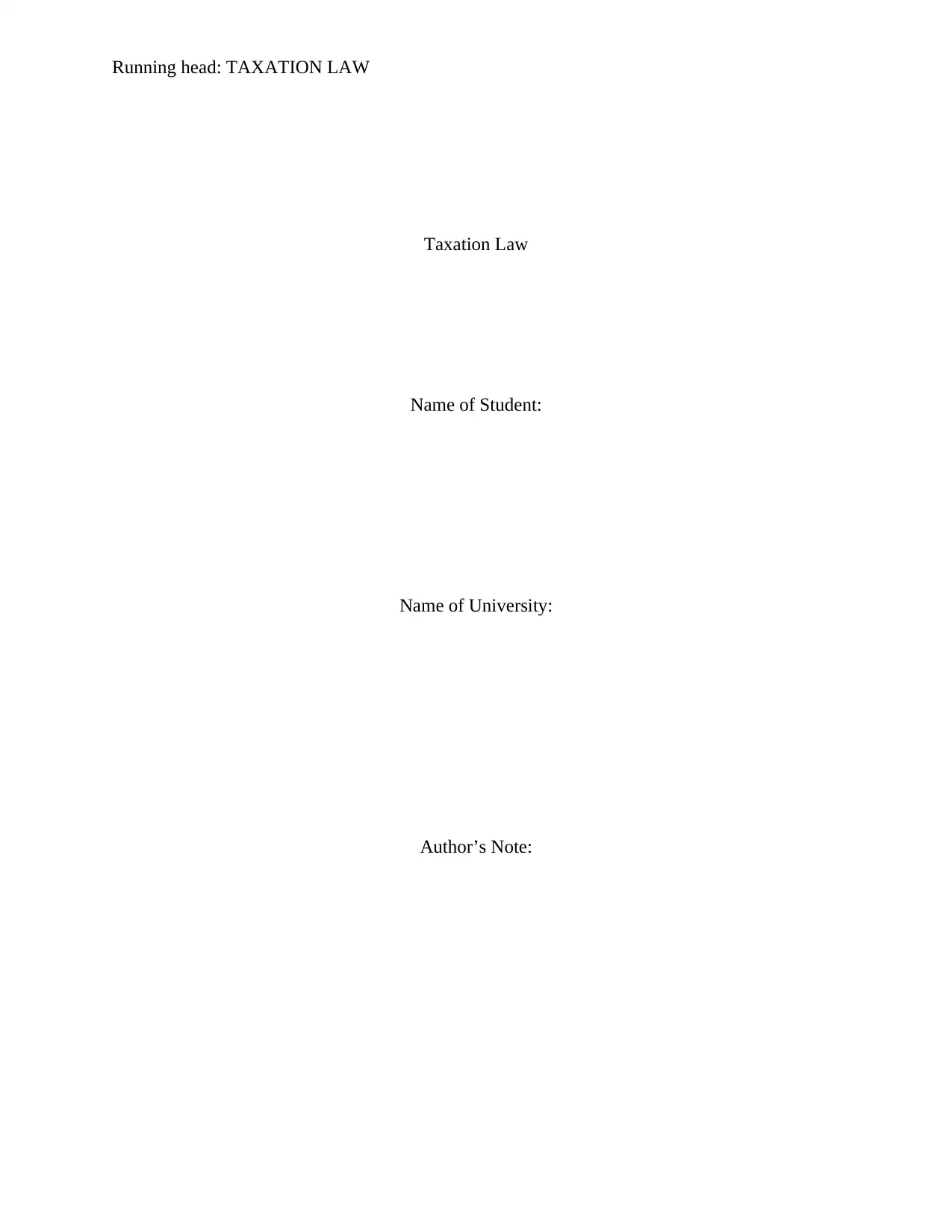
Running head: TAXATION LAW
Taxation Law
Name of Student:
Name of University:
Author’s Note:
Taxation Law
Name of Student:
Name of University:
Author’s Note:
Secure Best Marks with AI Grader
Need help grading? Try our AI Grader for instant feedback on your assignments.
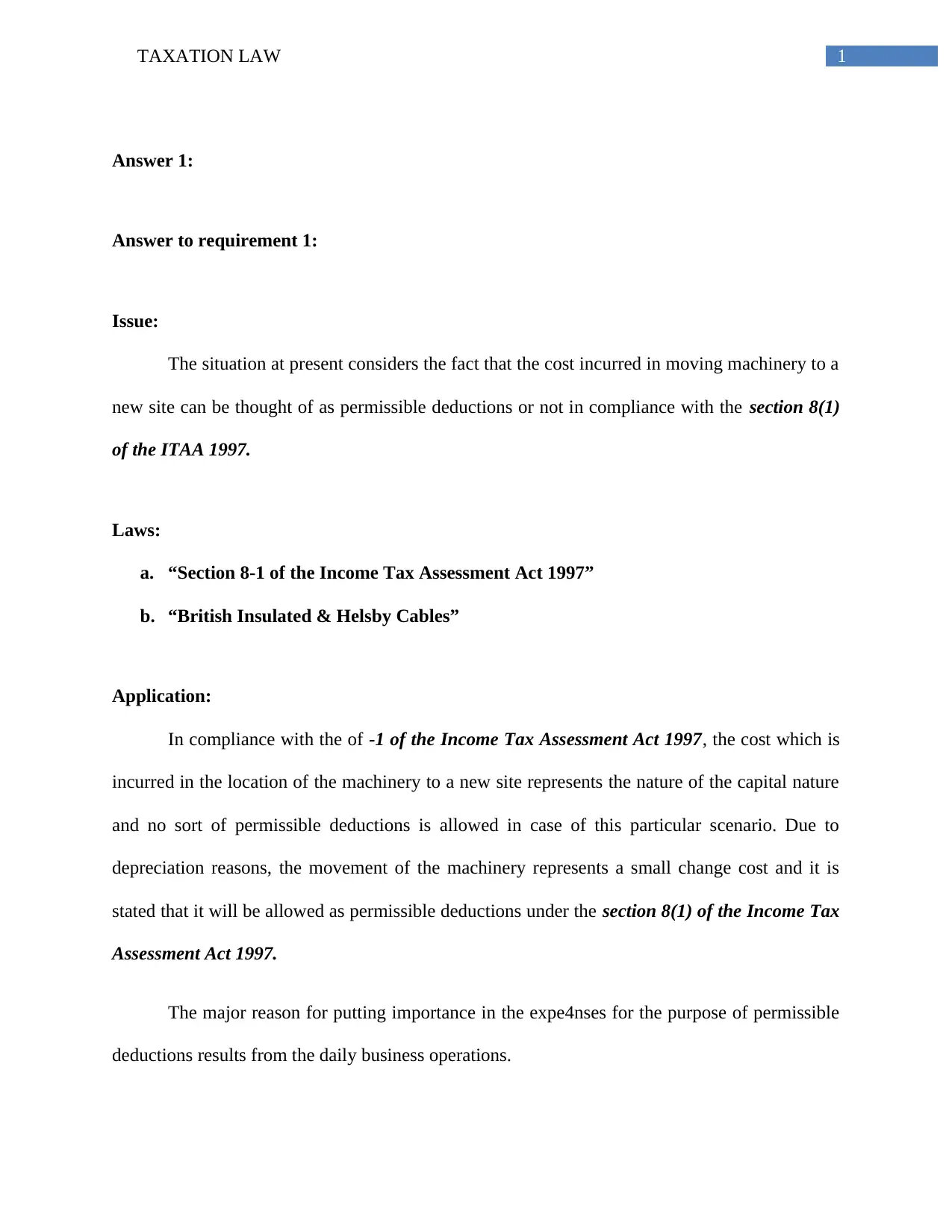
1TAXATION LAW
Answer 1:
Answer to requirement 1:
Issue:
The situation at present considers the fact that the cost incurred in moving machinery to a
new site can be thought of as permissible deductions or not in compliance with the section 8(1)
of the ITAA 1997.
Laws:
a. “Section 8-1 of the Income Tax Assessment Act 1997”
b. “British Insulated & Helsby Cables”
Application:
In compliance with the of -1 of the Income Tax Assessment Act 1997, the cost which is
incurred in the location of the machinery to a new site represents the nature of the capital nature
and no sort of permissible deductions is allowed in case of this particular scenario. Due to
depreciation reasons, the movement of the machinery represents a small change cost and it is
stated that it will be allowed as permissible deductions under the section 8(1) of the Income Tax
Assessment Act 1997.
The major reason for putting importance in the expe4nses for the purpose of permissible
deductions results from the daily business operations.
Answer 1:
Answer to requirement 1:
Issue:
The situation at present considers the fact that the cost incurred in moving machinery to a
new site can be thought of as permissible deductions or not in compliance with the section 8(1)
of the ITAA 1997.
Laws:
a. “Section 8-1 of the Income Tax Assessment Act 1997”
b. “British Insulated & Helsby Cables”
Application:
In compliance with the of -1 of the Income Tax Assessment Act 1997, the cost which is
incurred in the location of the machinery to a new site represents the nature of the capital nature
and no sort of permissible deductions is allowed in case of this particular scenario. Due to
depreciation reasons, the movement of the machinery represents a small change cost and it is
stated that it will be allowed as permissible deductions under the section 8(1) of the Income Tax
Assessment Act 1997.
The major reason for putting importance in the expe4nses for the purpose of permissible
deductions results from the daily business operations.

2TAXATION LAW
Based on the British Insulated & Helsby Cables verdict the involved cost in the
transportation is characteristic of the increasing benefit on the business related premises due to
shift of the depreciable assets.
According to the Taxation Ruling of TD 93/126, the machinery installation and the
beginning of the business functions the occurrence cost in bringing the machine for the complete
operation is to be considered as revenue. It is clearly inferred from the above situation that the
locating of the machine to the new site is to be treated as non-allowable deductions (Reaves and
Bauer 2012).
Conclusion:
The obtained cost in movement of the machine to a new site is representative of the
movement of an asset from a particular place to another. It is also noted that it is to be considered
as capital expenditure (Posner 2014). In connection to this the permissible deductions will be
allowed in compliance with section 8(1) of the Income Tax Assessment Act 1997.
Answer to requirement 2:
Issue:
The situation helps in understanding if the revaluation of the assets to affect the cover of
insurance would be viewed as allowable deductions in compliance with the “section 8(1) of the
Income Tax Assessment Act 1997”.
Laws:
a. “Section 8-1 of the Income Tax Assessment Act 1997”
Based on the British Insulated & Helsby Cables verdict the involved cost in the
transportation is characteristic of the increasing benefit on the business related premises due to
shift of the depreciable assets.
According to the Taxation Ruling of TD 93/126, the machinery installation and the
beginning of the business functions the occurrence cost in bringing the machine for the complete
operation is to be considered as revenue. It is clearly inferred from the above situation that the
locating of the machine to the new site is to be treated as non-allowable deductions (Reaves and
Bauer 2012).
Conclusion:
The obtained cost in movement of the machine to a new site is representative of the
movement of an asset from a particular place to another. It is also noted that it is to be considered
as capital expenditure (Posner 2014). In connection to this the permissible deductions will be
allowed in compliance with section 8(1) of the Income Tax Assessment Act 1997.
Answer to requirement 2:
Issue:
The situation helps in understanding if the revaluation of the assets to affect the cover of
insurance would be viewed as allowable deductions in compliance with the “section 8(1) of the
Income Tax Assessment Act 1997”.
Laws:
a. “Section 8-1 of the Income Tax Assessment Act 1997”
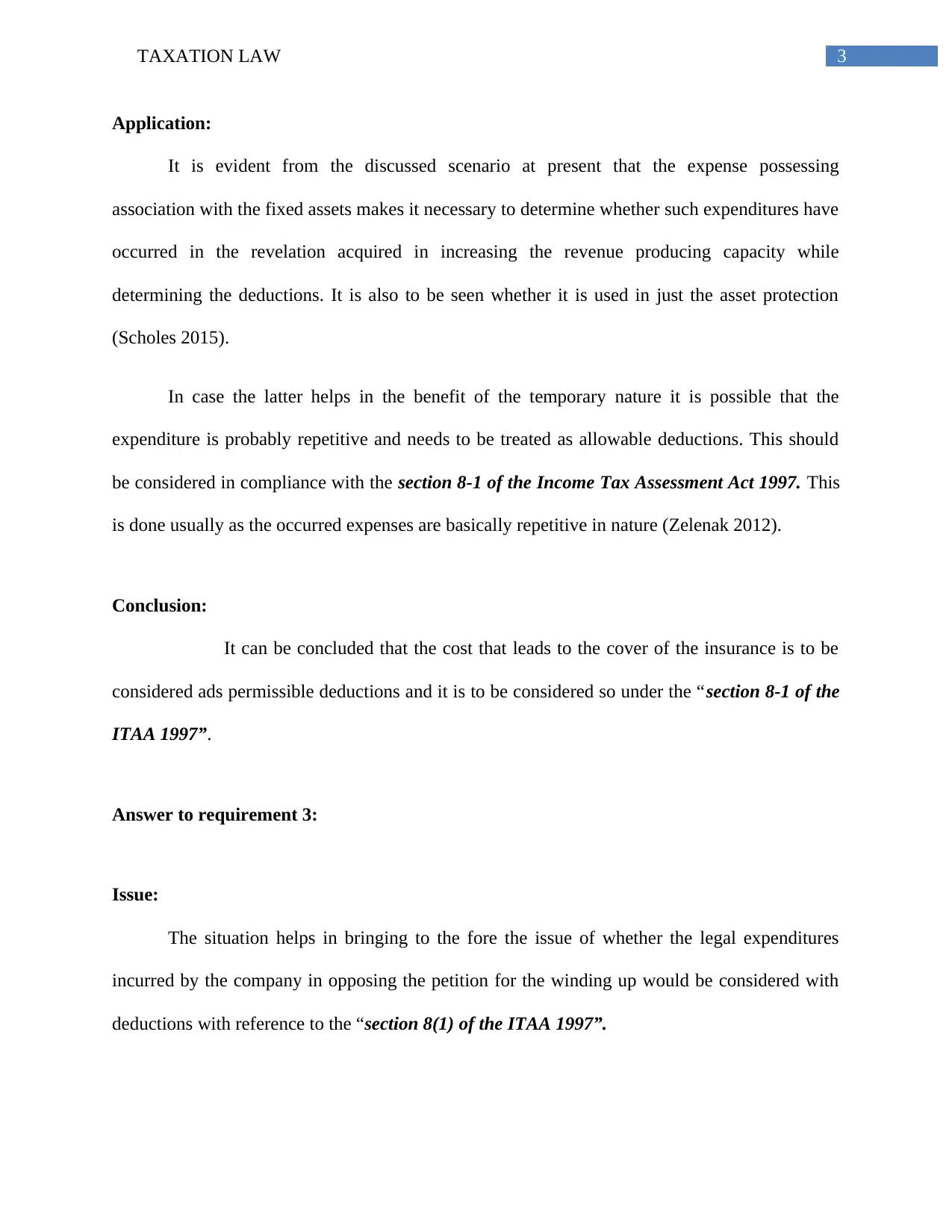
3TAXATION LAW
Application:
It is evident from the discussed scenario at present that the expense possessing
association with the fixed assets makes it necessary to determine whether such expenditures have
occurred in the revelation acquired in increasing the revenue producing capacity while
determining the deductions. It is also to be seen whether it is used in just the asset protection
(Scholes 2015).
In case the latter helps in the benefit of the temporary nature it is possible that the
expenditure is probably repetitive and needs to be treated as allowable deductions. This should
be considered in compliance with the section 8-1 of the Income Tax Assessment Act 1997. This
is done usually as the occurred expenses are basically repetitive in nature (Zelenak 2012).
Conclusion:
It can be concluded that the cost that leads to the cover of the insurance is to be
considered ads permissible deductions and it is to be considered so under the “section 8-1 of the
ITAA 1997”.
Answer to requirement 3:
Issue:
The situation helps in bringing to the fore the issue of whether the legal expenditures
incurred by the company in opposing the petition for the winding up would be considered with
deductions with reference to the “section 8(1) of the ITAA 1997”.
Application:
It is evident from the discussed scenario at present that the expense possessing
association with the fixed assets makes it necessary to determine whether such expenditures have
occurred in the revelation acquired in increasing the revenue producing capacity while
determining the deductions. It is also to be seen whether it is used in just the asset protection
(Scholes 2015).
In case the latter helps in the benefit of the temporary nature it is possible that the
expenditure is probably repetitive and needs to be treated as allowable deductions. This should
be considered in compliance with the section 8-1 of the Income Tax Assessment Act 1997. This
is done usually as the occurred expenses are basically repetitive in nature (Zelenak 2012).
Conclusion:
It can be concluded that the cost that leads to the cover of the insurance is to be
considered ads permissible deductions and it is to be considered so under the “section 8-1 of the
ITAA 1997”.
Answer to requirement 3:
Issue:
The situation helps in bringing to the fore the issue of whether the legal expenditures
incurred by the company in opposing the petition for the winding up would be considered with
deductions with reference to the “section 8(1) of the ITAA 1997”.
Secure Best Marks with AI Grader
Need help grading? Try our AI Grader for instant feedback on your assignments.
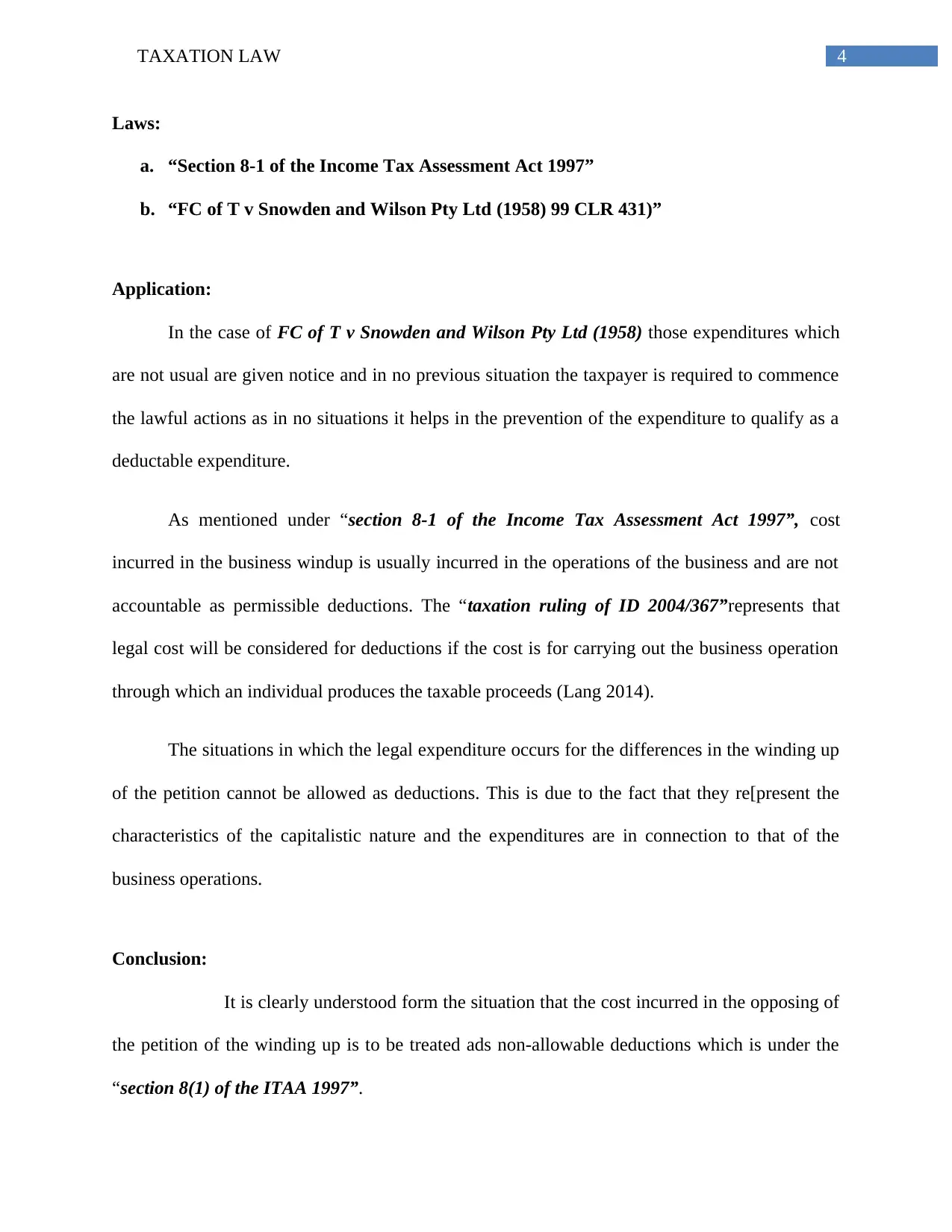
4TAXATION LAW
Laws:
a. “Section 8-1 of the Income Tax Assessment Act 1997”
b. “FC of T v Snowden and Wilson Pty Ltd (1958) 99 CLR 431)”
Application:
In the case of FC of T v Snowden and Wilson Pty Ltd (1958) those expenditures which
are not usual are given notice and in no previous situation the taxpayer is required to commence
the lawful actions as in no situations it helps in the prevention of the expenditure to qualify as a
deductable expenditure.
As mentioned under “section 8-1 of the Income Tax Assessment Act 1997”, cost
incurred in the business windup is usually incurred in the operations of the business and are not
accountable as permissible deductions. The “taxation ruling of ID 2004/367”represents that
legal cost will be considered for deductions if the cost is for carrying out the business operation
through which an individual produces the taxable proceeds (Lang 2014).
The situations in which the legal expenditure occurs for the differences in the winding up
of the petition cannot be allowed as deductions. This is due to the fact that they re[present the
characteristics of the capitalistic nature and the expenditures are in connection to that of the
business operations.
Conclusion:
It is clearly understood form the situation that the cost incurred in the opposing of
the petition of the winding up is to be treated ads non-allowable deductions which is under the
“section 8(1) of the ITAA 1997”.
Laws:
a. “Section 8-1 of the Income Tax Assessment Act 1997”
b. “FC of T v Snowden and Wilson Pty Ltd (1958) 99 CLR 431)”
Application:
In the case of FC of T v Snowden and Wilson Pty Ltd (1958) those expenditures which
are not usual are given notice and in no previous situation the taxpayer is required to commence
the lawful actions as in no situations it helps in the prevention of the expenditure to qualify as a
deductable expenditure.
As mentioned under “section 8-1 of the Income Tax Assessment Act 1997”, cost
incurred in the business windup is usually incurred in the operations of the business and are not
accountable as permissible deductions. The “taxation ruling of ID 2004/367”represents that
legal cost will be considered for deductions if the cost is for carrying out the business operation
through which an individual produces the taxable proceeds (Lang 2014).
The situations in which the legal expenditure occurs for the differences in the winding up
of the petition cannot be allowed as deductions. This is due to the fact that they re[present the
characteristics of the capitalistic nature and the expenditures are in connection to that of the
business operations.
Conclusion:
It is clearly understood form the situation that the cost incurred in the opposing of
the petition of the winding up is to be treated ads non-allowable deductions which is under the
“section 8(1) of the ITAA 1997”.
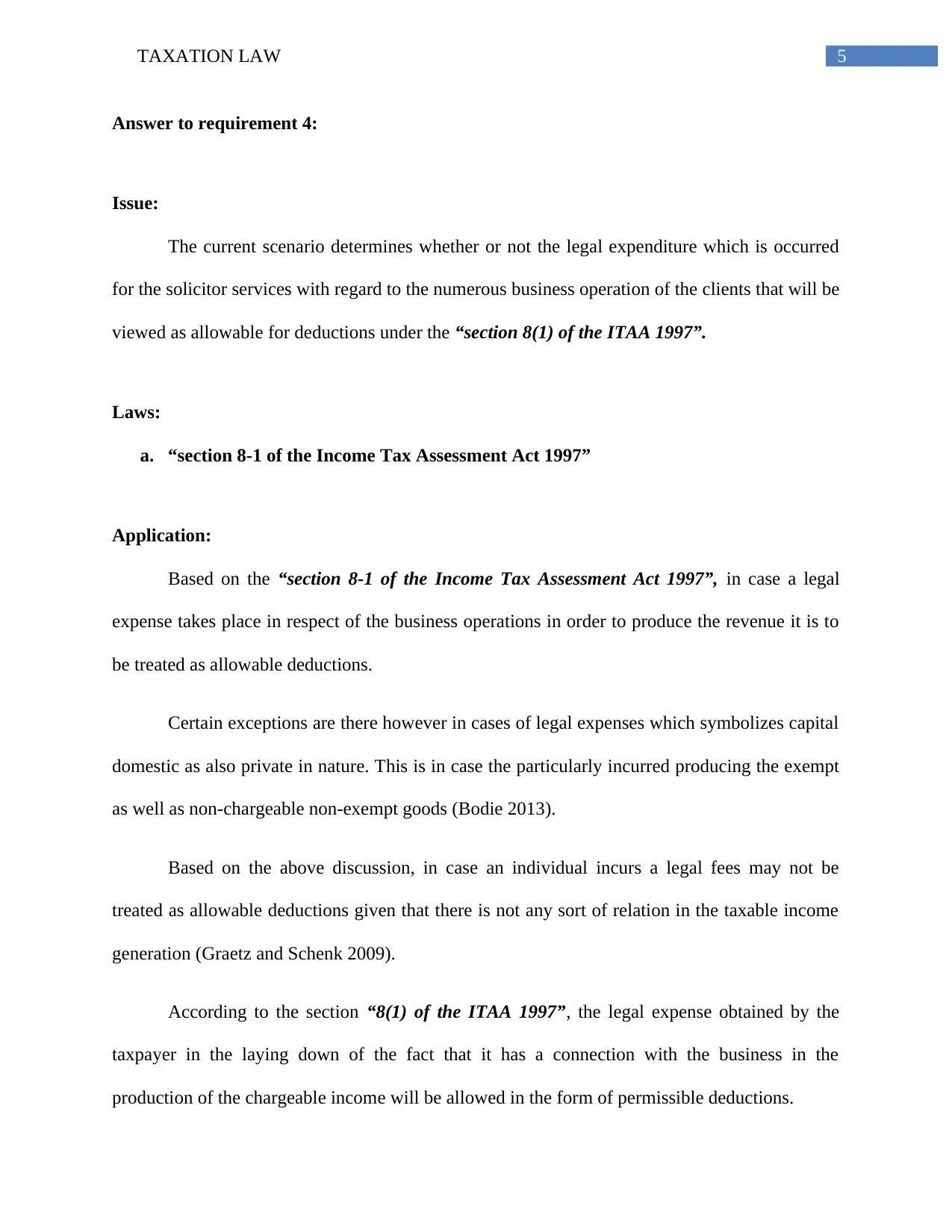
5TAXATION LAW
Answer to requirement 4:
Issue:
The current scenario determines whether or not the legal expenditure which is occurred
for the solicitor services with regard to the numerous business operation of the clients that will be
viewed as allowable for deductions under the “section 8(1) of the ITAA 1997”.
Laws:
a. “section 8-1 of the Income Tax Assessment Act 1997”
Application:
Based on the “section 8-1 of the Income Tax Assessment Act 1997”, in case a legal
expense takes place in respect of the business operations in order to produce the revenue it is to
be treated as allowable deductions.
Certain exceptions are there however in cases of legal expenses which symbolizes capital
domestic as also private in nature. This is in case the particularly incurred producing the exempt
as well as non-chargeable non-exempt goods (Bodie 2013).
Based on the above discussion, in case an individual incurs a legal fees may not be
treated as allowable deductions given that there is not any sort of relation in the taxable income
generation (Graetz and Schenk 2009).
According to the section “8(1) of the ITAA 1997”, the legal expense obtained by the
taxpayer in the laying down of the fact that it has a connection with the business in the
production of the chargeable income will be allowed in the form of permissible deductions.
Answer to requirement 4:
Issue:
The current scenario determines whether or not the legal expenditure which is occurred
for the solicitor services with regard to the numerous business operation of the clients that will be
viewed as allowable for deductions under the “section 8(1) of the ITAA 1997”.
Laws:
a. “section 8-1 of the Income Tax Assessment Act 1997”
Application:
Based on the “section 8-1 of the Income Tax Assessment Act 1997”, in case a legal
expense takes place in respect of the business operations in order to produce the revenue it is to
be treated as allowable deductions.
Certain exceptions are there however in cases of legal expenses which symbolizes capital
domestic as also private in nature. This is in case the particularly incurred producing the exempt
as well as non-chargeable non-exempt goods (Bodie 2013).
Based on the above discussion, in case an individual incurs a legal fees may not be
treated as allowable deductions given that there is not any sort of relation in the taxable income
generation (Graetz and Schenk 2009).
According to the section “8(1) of the ITAA 1997”, the legal expense obtained by the
taxpayer in the laying down of the fact that it has a connection with the business in the
production of the chargeable income will be allowed in the form of permissible deductions.
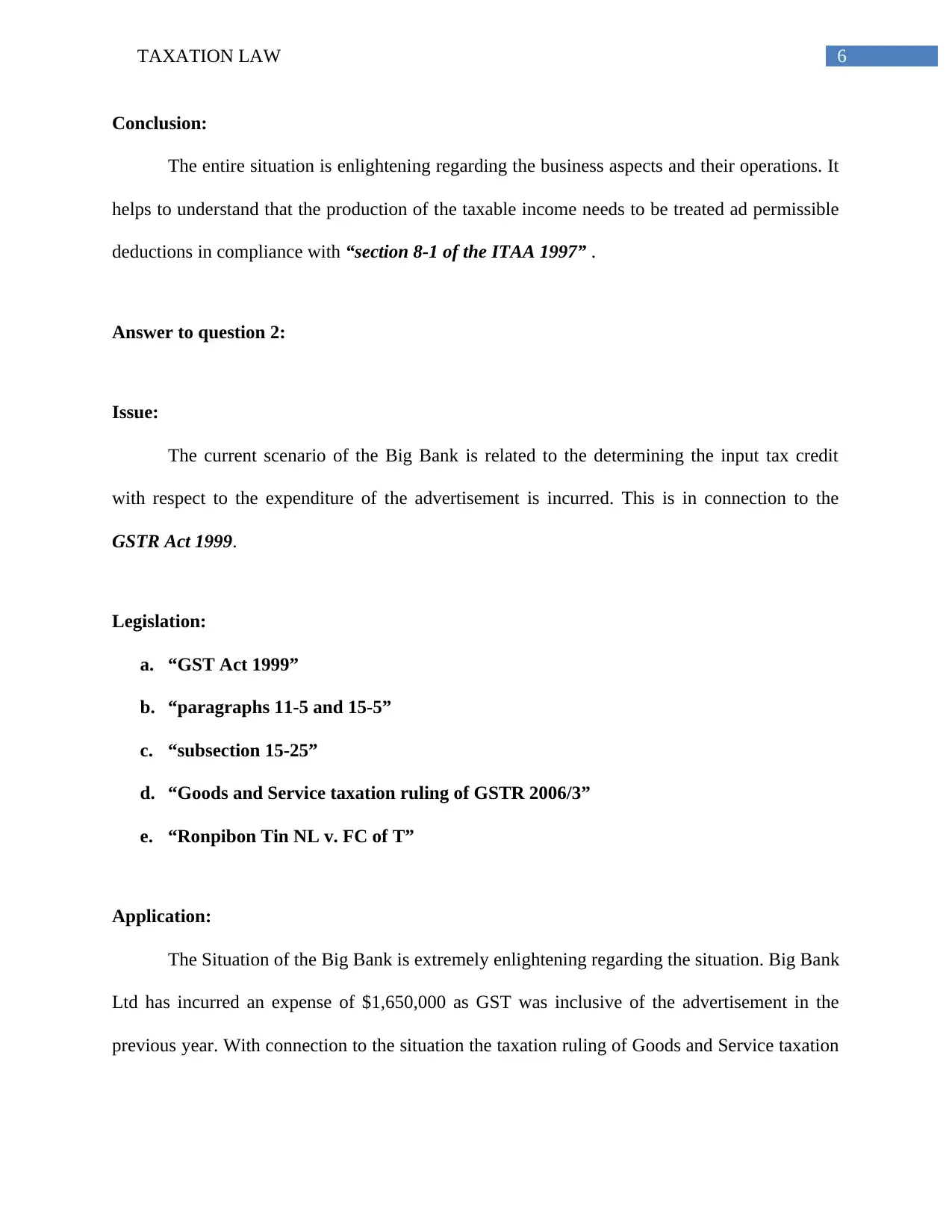
6TAXATION LAW
Conclusion:
The entire situation is enlightening regarding the business aspects and their operations. It
helps to understand that the production of the taxable income needs to be treated ad permissible
deductions in compliance with “section 8-1 of the ITAA 1997” .
Answer to question 2:
Issue:
The current scenario of the Big Bank is related to the determining the input tax credit
with respect to the expenditure of the advertisement is incurred. This is in connection to the
GSTR Act 1999.
Legislation:
a. “GST Act 1999”
b. “paragraphs 11-5 and 15-5”
c. “subsection 15-25”
d. “Goods and Service taxation ruling of GSTR 2006/3”
e. “Ronpibon Tin NL v. FC of T”
Application:
The Situation of the Big Bank is extremely enlightening regarding the situation. Big Bank
Ltd has incurred an expense of $1,650,000 as GST was inclusive of the advertisement in the
previous year. With connection to the situation the taxation ruling of Goods and Service taxation
Conclusion:
The entire situation is enlightening regarding the business aspects and their operations. It
helps to understand that the production of the taxable income needs to be treated ad permissible
deductions in compliance with “section 8-1 of the ITAA 1997” .
Answer to question 2:
Issue:
The current scenario of the Big Bank is related to the determining the input tax credit
with respect to the expenditure of the advertisement is incurred. This is in connection to the
GSTR Act 1999.
Legislation:
a. “GST Act 1999”
b. “paragraphs 11-5 and 15-5”
c. “subsection 15-25”
d. “Goods and Service taxation ruling of GSTR 2006/3”
e. “Ronpibon Tin NL v. FC of T”
Application:
The Situation of the Big Bank is extremely enlightening regarding the situation. Big Bank
Ltd has incurred an expense of $1,650,000 as GST was inclusive of the advertisement in the
previous year. With connection to the situation the taxation ruling of Goods and Service taxation
Paraphrase This Document
Need a fresh take? Get an instant paraphrase of this document with our AI Paraphraser
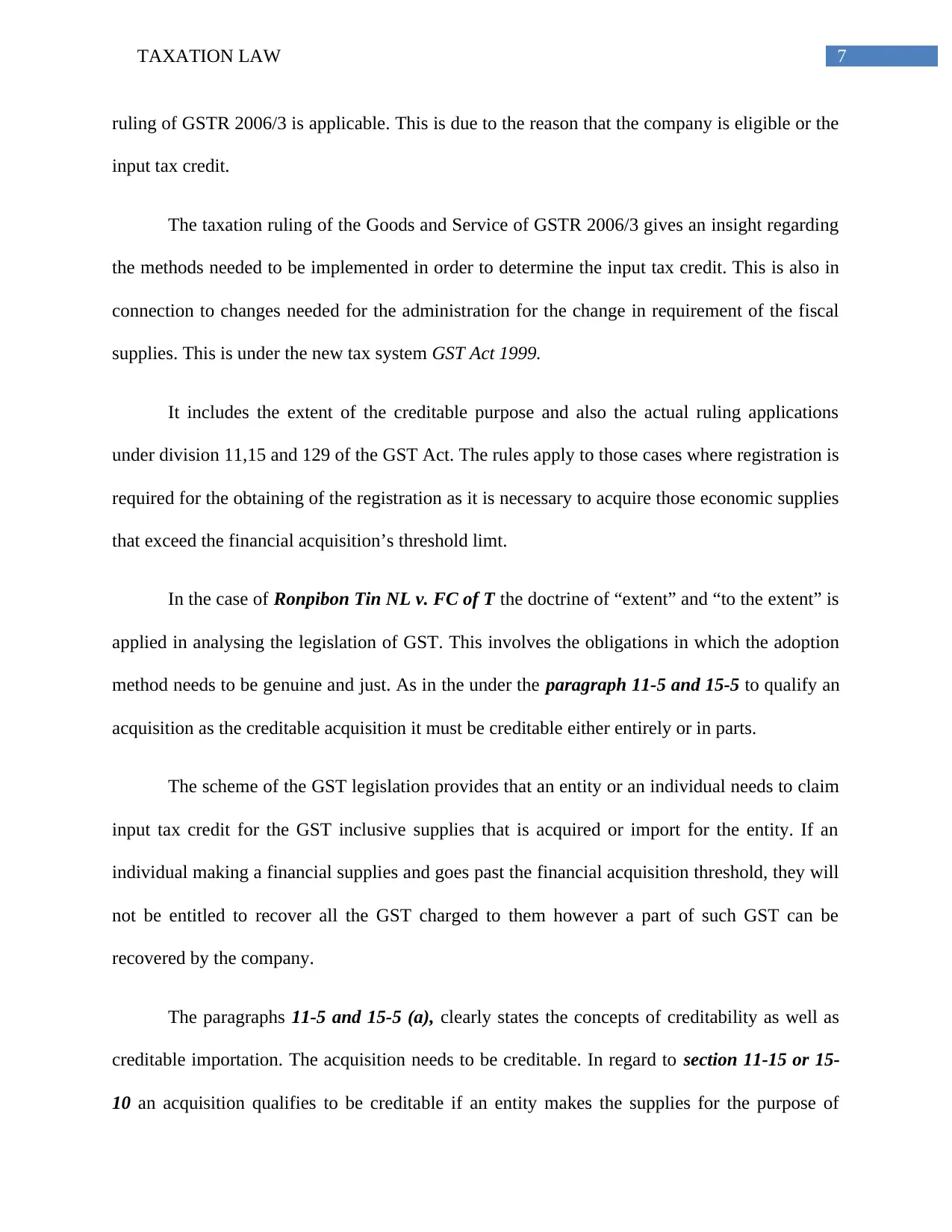
7TAXATION LAW
ruling of GSTR 2006/3 is applicable. This is due to the reason that the company is eligible or the
input tax credit.
The taxation ruling of the Goods and Service of GSTR 2006/3 gives an insight regarding
the methods needed to be implemented in order to determine the input tax credit. This is also in
connection to changes needed for the administration for the change in requirement of the fiscal
supplies. This is under the new tax system GST Act 1999.
It includes the extent of the creditable purpose and also the actual ruling applications
under division 11,15 and 129 of the GST Act. The rules apply to those cases where registration is
required for the obtaining of the registration as it is necessary to acquire those economic supplies
that exceed the financial acquisition’s threshold limt.
In the case of Ronpibon Tin NL v. FC of T the doctrine of “extent” and “to the extent” is
applied in analysing the legislation of GST. This involves the obligations in which the adoption
method needs to be genuine and just. As in the under the paragraph 11-5 and 15-5 to qualify an
acquisition as the creditable acquisition it must be creditable either entirely or in parts.
The scheme of the GST legislation provides that an entity or an individual needs to claim
input tax credit for the GST inclusive supplies that is acquired or import for the entity. If an
individual making a financial supplies and goes past the financial acquisition threshold, they will
not be entitled to recover all the GST charged to them however a part of such GST can be
recovered by the company.
The paragraphs 11-5 and 15-5 (a), clearly states the concepts of creditability as well as
creditable importation. The acquisition needs to be creditable. In regard to section 11-15 or 15-
10 an acquisition qualifies to be creditable if an entity makes the supplies for the purpose of
ruling of GSTR 2006/3 is applicable. This is due to the reason that the company is eligible or the
input tax credit.
The taxation ruling of the Goods and Service of GSTR 2006/3 gives an insight regarding
the methods needed to be implemented in order to determine the input tax credit. This is also in
connection to changes needed for the administration for the change in requirement of the fiscal
supplies. This is under the new tax system GST Act 1999.
It includes the extent of the creditable purpose and also the actual ruling applications
under division 11,15 and 129 of the GST Act. The rules apply to those cases where registration is
required for the obtaining of the registration as it is necessary to acquire those economic supplies
that exceed the financial acquisition’s threshold limt.
In the case of Ronpibon Tin NL v. FC of T the doctrine of “extent” and “to the extent” is
applied in analysing the legislation of GST. This involves the obligations in which the adoption
method needs to be genuine and just. As in the under the paragraph 11-5 and 15-5 to qualify an
acquisition as the creditable acquisition it must be creditable either entirely or in parts.
The scheme of the GST legislation provides that an entity or an individual needs to claim
input tax credit for the GST inclusive supplies that is acquired or import for the entity. If an
individual making a financial supplies and goes past the financial acquisition threshold, they will
not be entitled to recover all the GST charged to them however a part of such GST can be
recovered by the company.
The paragraphs 11-5 and 15-5 (a), clearly states the concepts of creditability as well as
creditable importation. The acquisition needs to be creditable. In regard to section 11-15 or 15-
10 an acquisition qualifies to be creditable if an entity makes the supplies for the purpose of
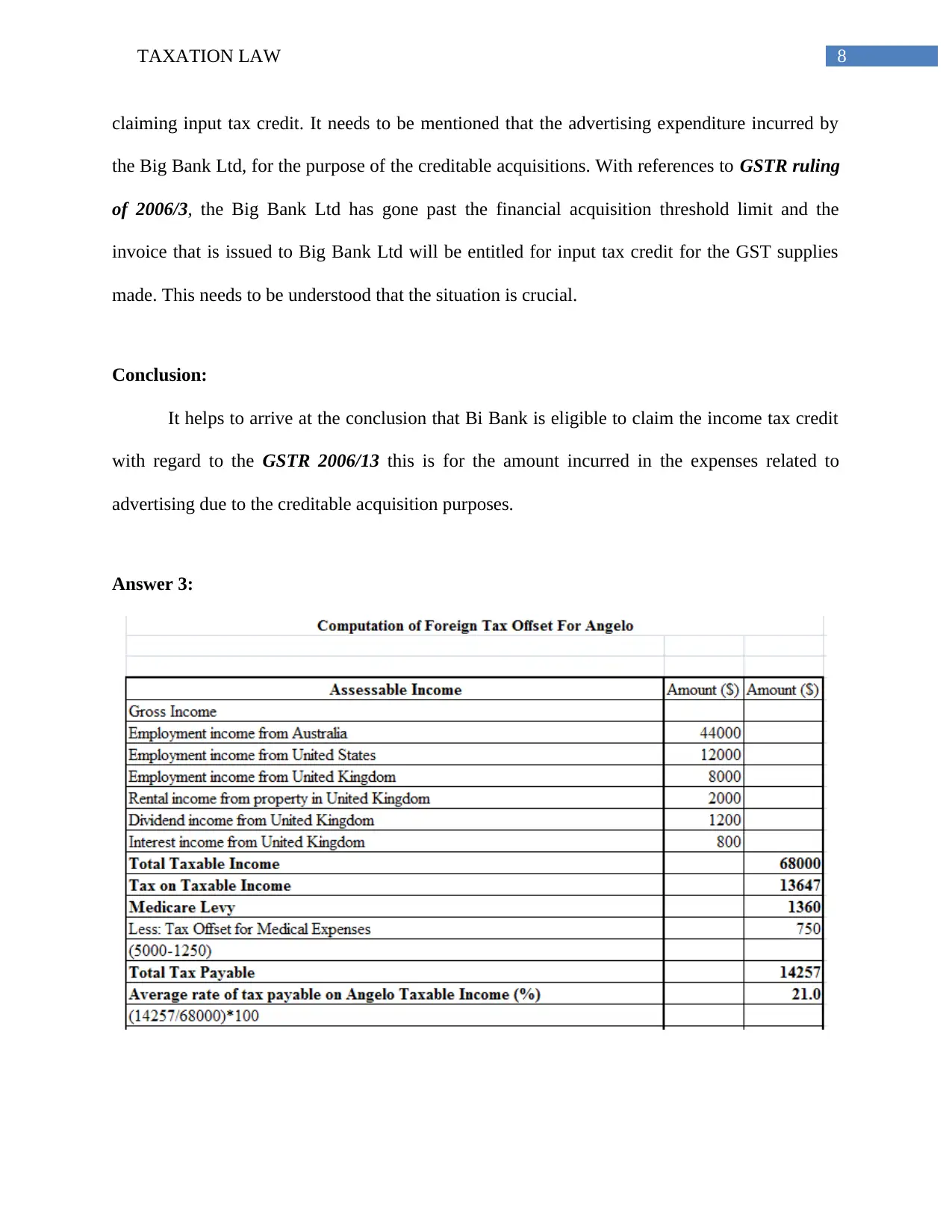
8TAXATION LAW
claiming input tax credit. It needs to be mentioned that the advertising expenditure incurred by
the Big Bank Ltd, for the purpose of the creditable acquisitions. With references to GSTR ruling
of 2006/3, the Big Bank Ltd has gone past the financial acquisition threshold limit and the
invoice that is issued to Big Bank Ltd will be entitled for input tax credit for the GST supplies
made. This needs to be understood that the situation is crucial.
Conclusion:
It helps to arrive at the conclusion that Bi Bank is eligible to claim the income tax credit
with regard to the GSTR 2006/13 this is for the amount incurred in the expenses related to
advertising due to the creditable acquisition purposes.
Answer 3:
claiming input tax credit. It needs to be mentioned that the advertising expenditure incurred by
the Big Bank Ltd, for the purpose of the creditable acquisitions. With references to GSTR ruling
of 2006/3, the Big Bank Ltd has gone past the financial acquisition threshold limit and the
invoice that is issued to Big Bank Ltd will be entitled for input tax credit for the GST supplies
made. This needs to be understood that the situation is crucial.
Conclusion:
It helps to arrive at the conclusion that Bi Bank is eligible to claim the income tax credit
with regard to the GSTR 2006/13 this is for the amount incurred in the expenses related to
advertising due to the creditable acquisition purposes.
Answer 3:
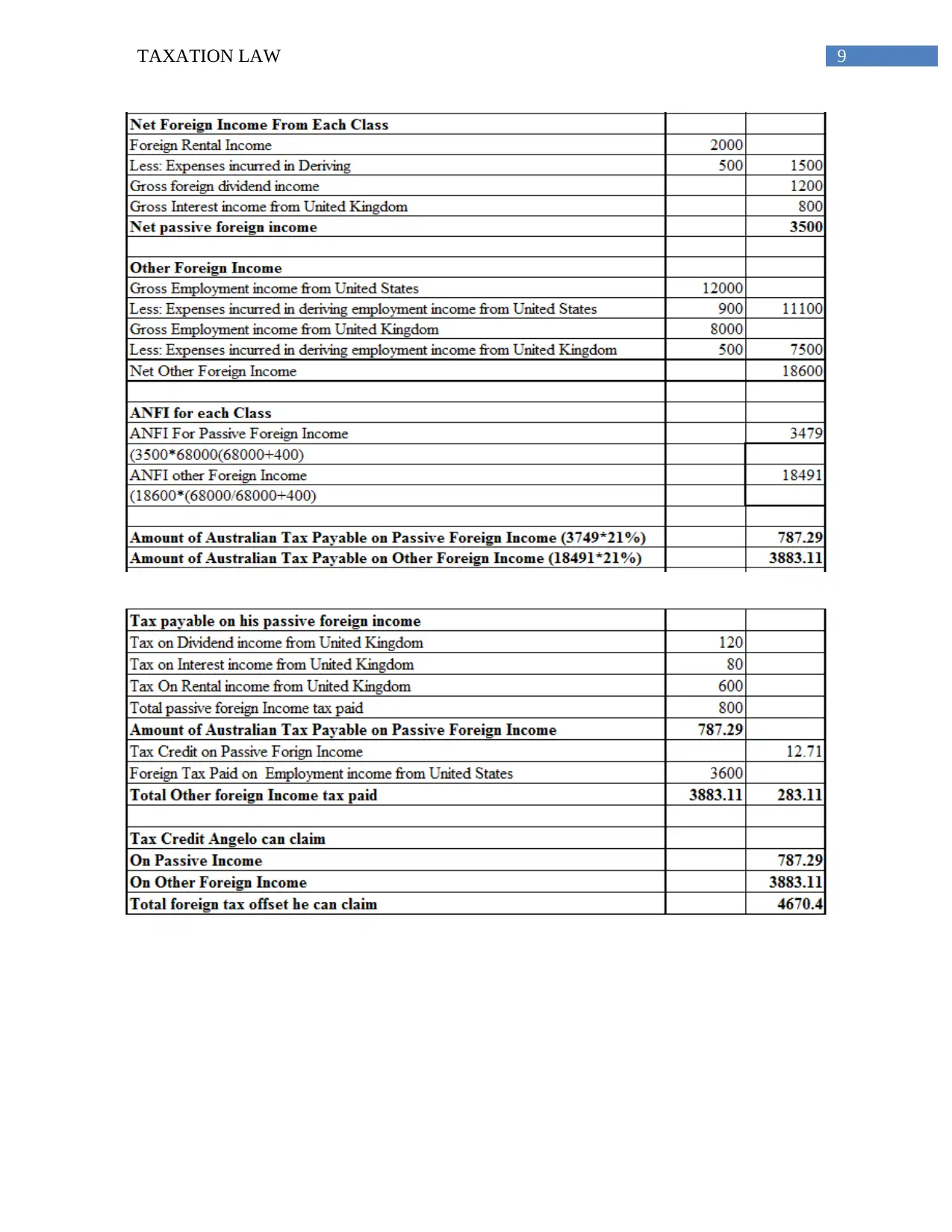
9TAXATION LAW
Secure Best Marks with AI Grader
Need help grading? Try our AI Grader for instant feedback on your assignments.

10TAXATION LAW
Answer 4:
Answer 4:
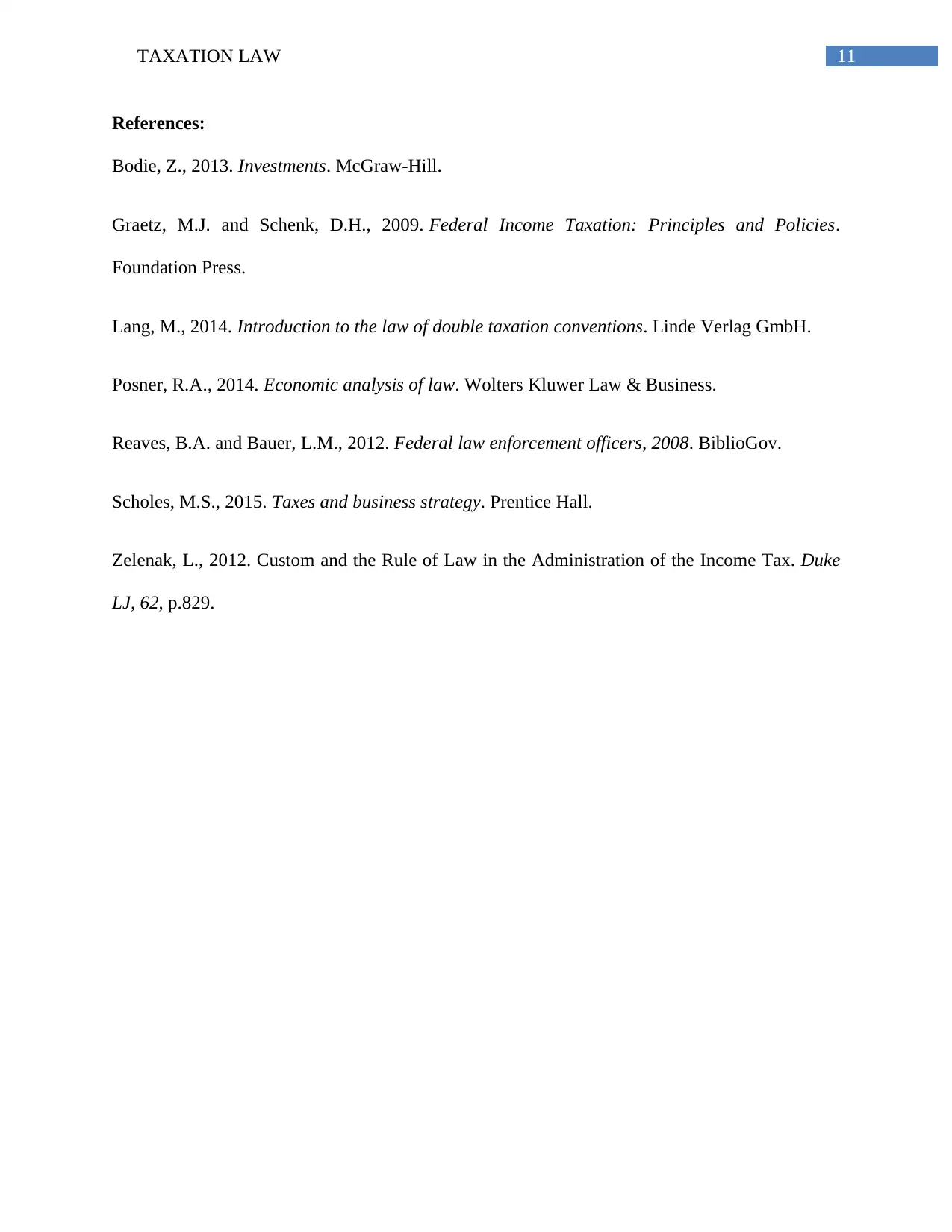
11TAXATION LAW
References:
Bodie, Z., 2013. Investments. McGraw-Hill.
Graetz, M.J. and Schenk, D.H., 2009. Federal Income Taxation: Principles and Policies.
Foundation Press.
Lang, M., 2014. Introduction to the law of double taxation conventions. Linde Verlag GmbH.
Posner, R.A., 2014. Economic analysis of law. Wolters Kluwer Law & Business.
Reaves, B.A. and Bauer, L.M., 2012. Federal law enforcement officers, 2008. BiblioGov.
Scholes, M.S., 2015. Taxes and business strategy. Prentice Hall.
Zelenak, L., 2012. Custom and the Rule of Law in the Administration of the Income Tax. Duke
LJ, 62, p.829.
References:
Bodie, Z., 2013. Investments. McGraw-Hill.
Graetz, M.J. and Schenk, D.H., 2009. Federal Income Taxation: Principles and Policies.
Foundation Press.
Lang, M., 2014. Introduction to the law of double taxation conventions. Linde Verlag GmbH.
Posner, R.A., 2014. Economic analysis of law. Wolters Kluwer Law & Business.
Reaves, B.A. and Bauer, L.M., 2012. Federal law enforcement officers, 2008. BiblioGov.
Scholes, M.S., 2015. Taxes and business strategy. Prentice Hall.
Zelenak, L., 2012. Custom and the Rule of Law in the Administration of the Income Tax. Duke
LJ, 62, p.829.
1 out of 12
Related Documents
Your All-in-One AI-Powered Toolkit for Academic Success.
+13062052269
info@desklib.com
Available 24*7 on WhatsApp / Email
![[object Object]](/_next/static/media/star-bottom.7253800d.svg)
Unlock your academic potential
© 2024 | Zucol Services PVT LTD | All rights reserved.





